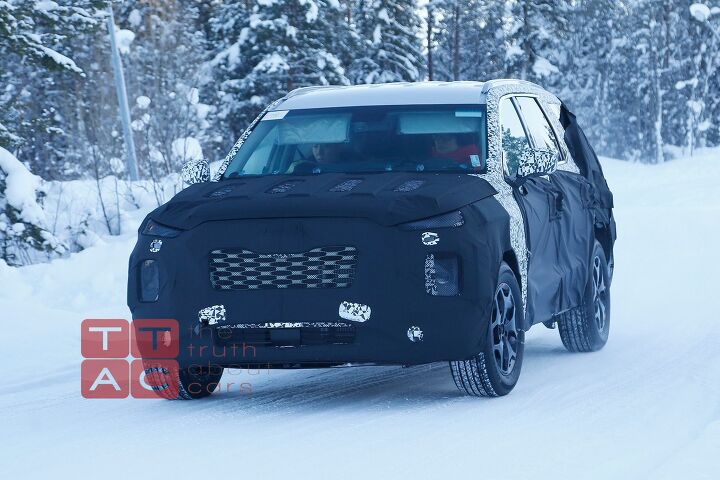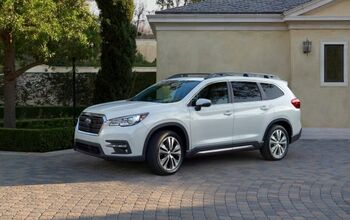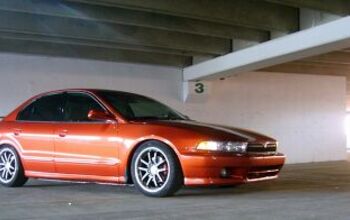When You're This Big, They Call You Grandmaster

If you’re following the Busan International Motor Show as close as we are, and we know you are, you no doubt saw the unveiling of Hyundai’s newest and largest concept vehicle, the HDC-2 Grandmaster. Sounding like an air-dropped fission weapon or perhaps an experimental jet prototype of the 1940s, Hyundai’s big, honkin’ SUV concept showcases where the company’s going with its design language.
It’s also possible you’ve seen the Grandmaster’s shape before, perhaps churning up the snow on a wintery test course in a set of spy photos.
Earlier this year, we got our hands on pics of a well-camouflaged unibody utility vehicle traipsing through the powder. The model in question, while not officially named, is expected to become the pinnacle of Hyundai’s crossover range, positioned above the Santa Fe (formerly the Santa Fe Sport) and replacing the Santa Fe XL (formerly the Santa Fe). Hyundai claims it wanted a vehicle that appeals to an American clientele, and you know what that means. Big, blunt, and imposing.
Based on a U.S. trademark application, it’s possible the range-topper will carry the “Palisade” name. Both vehicles can be seen below:
For the record (and the less cultured among us), Hyundai’s choice of “Grandmaster” for its concept relates to chess, not the fellow who hung out with the Furious Five.
Minus the oversimplified front end treatment and oversized wheels, the Grandmaster’s proportions looks pretty similar to the vehicle seen in those snowy photos, so what we’re seeing roll out in Busan is a taste of real product to come. Referring to the concept as a “blueprint for our evolved design strategy,” SangYup Lee, Vice President and head of Hyundai styling, said “we will move towards becoming a brand that customers can really relate to emotionally. Moving on from being a brand that provides a great value, we will aspire to also become a brand that is widely beloved by our customers.”
It’s no wonder why Hyundai’s new design strategy carries the tongue-tying label of “sensuous sportiness.” Who doesn’t want to be either of those things?
While full-size crossover buyers seem to prefer a brawny looking vehicle that hides the fact it lacks a ladder frame or solid rear axle (*cough* Chevy Traverse *cough*), designers delve a little deeper into the buyer’s subconscious. According to Hyundai, the concept’s styling harmonizes “four key elements – proportion, architecture, styling and technology – thereby bringing emotional value and desirability.”
Hyundai sure hopes buyers feel the pull. The automaker’s American comeback strategy hinges on the popularity of the new crossovers coming down the pipe, especially models like the Palisade(?) and revamped Santa Fe. Interestingly, it’s because of crossovers that Hyundai posted its first year-over-year monthly sales gain of 2018 in May. The automaker’s volume rose 11.5 percent last month. Credit goes to the recently-arrived subcompact Kona, which moved just over 5,000 units in March, plus modest sales increases for the Santa Fe family and Tucson.
[Images: Hyundai, Brian Williams/Spiedbilde]

More by Steph Willems
Latest Car Reviews
Read moreLatest Product Reviews
Read moreRecent Comments
- MaintenanceCosts Nobody here seems to acknowledge that there are multiple use cases for cars.Some people spend all their time driving all over the country and need every mile and minute of time savings. ICE cars are better for them right now.Some people only drive locally and fly when they travel. For them, there's probably a range number that works, and they don't really need more. For the uses for which we use our EV, that would be around 150 miles. The other thing about a low range requirement is it can make 120V charging viable. If you don't drive more than an average of about 40 miles/day, you can probably get enough electrons through a wall outlet. We spent over two years charging our Bolt only through 120V, while our house was getting rebuilt, and never had an issue.Those are extremes. There are all sorts of use cases in between, which probably represent the majority of drivers. For some users, what's needed is more range. But I think for most users, what's needed is better charging. Retrofit apartment garages like Tim's with 240V outlets at every spot. Install more L3 chargers in supermarket parking lots and alongside gas stations. Make chargers that work like Tesla Superchargers as ubiquitous as gas stations, and EV charging will not be an issue for most users.
- MaintenanceCosts I don't have an opinion on whether any one plant unionizing is the right answer, but the employees sure need to have the right to organize. Unions or the credible threat of unionization are the only thing, history has proven, that can keep employers honest. Without it, we've seen over and over, the employers have complete power over the workers and feel free to exploit the workers however they see fit. (And don't tell me "oh, the workers can just leave" - in an oligopolistic industry, working conditions quickly converge, and there's not another employer right around the corner.)
- Kjhkjlhkjhkljh kljhjkhjklhkjh [h3]Wake me up when it is a 1989 635Csi with a M88/3[/h3]
- BrandX "I can charge using the 240V outlets, sure, but it’s slow."No it's not. That's what all home chargers use - 240V.
- Jalop1991 does the odometer represent itself in an analog fashion? Will the numbers roll slowly and stop wherever, or do they just blink to the next number like any old boring modern car?

































Comments
Join the conversation
Korean cars suck. I dont care.
“sensuous sportiness.” I used to feel that way about Sporty Spice - wait what were we talking about?